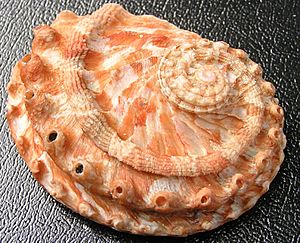Haliotis scalaris facts for kids
Haliotis scalaris, often called the staircase abalone or the ridged ear abalone, is a fascinating type of sea snail. It's a marine mollusk that belongs to the abalone family, known as Haliotidae. Abalones are famous for their beautiful, shiny shells.
Quick facts for kids Haliotis scalaris |
|
|---|---|
 |
|
| Apical view of a shell of Haliotis scalaris | |
| Scientific classification | |
| Synonyms | |
|
Contents
About the Staircase Abalone
What Does It Look Like?
The shell of the staircase abalone can be quite large. It usually measures between 60 mm (about 2.4 inches) and 100 mm (about 4 inches). Its shape is like a flattened oval.
The shell has a strong, rounded ridge on each side of its row of holes. These holes are usually 5 to 6 in number and are open. You can also see raised, wavy lines that spread out from the shell's top part, called the spire.
This abalone's shell is moderately large but not very thick. Its color can be reddish, or a mix of olive green and other shades. The outer surface has fine lines that spiral around it. It also has rough, raised patterns between the spire and the inner ridge.
The inside of the shell is very shiny and colorful, like a rainbow. This is called being iridescent. The inner surface also has dips that match the raised parts on the outside.
Where Does It Live?
The staircase abalone is a special animal because it is endemic to Australia. This means it is found naturally only in Australia and nowhere else in the world.
You can find this marine snail along the coast of Australia. Its habitat stretches from the South West (Western Australia) region of Western Australia all the way to Victoria. It also lives around the island of Tasmania.
Different Types of Staircase Abalone
Sometimes, animals of the same species can have slight differences depending on where they live. These variations are called subspecies. The staircase abalone has two known subspecies:
- Haliotis scalaris emmae Reeve, 1846
- Haliotis scalaris scalaris (Leach, 1814)

